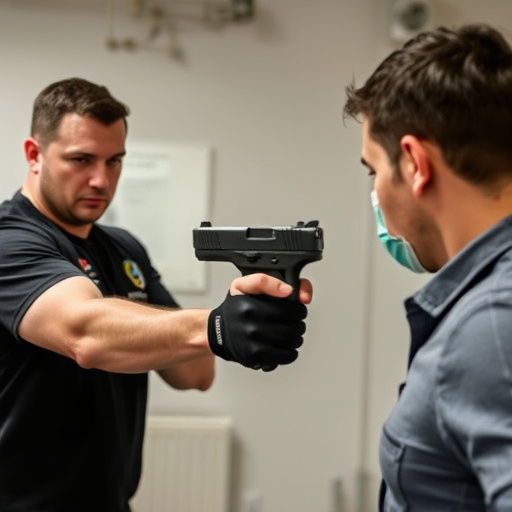Compact stun guns designed for purse carry utilize high-voltage pulses with precise control over electrical current spread, offering a powerful yet safe self-defense tool. Their effectiveness depends on factors like design, electrode placement, voltage levels, and environmental conditions, influencing the shock's range and intensity. Understanding these variables is crucial for researchers to optimize these devices, ensuring they are both safe and potent against attackers while maintaining user confidence. Spread pattern studies play a vital role in evaluating safety and efficacy, guiding manufacturers in balancing safety with effectiveness for compact stun guns in diverse real-world scenarios.
Electrical current spread patterns play a critical role in understanding the effectiveness of compact stun guns for personal safety. This article delves into the intricate behavior of electrical current, focusing on how it interacts with compact stun guns designed for purse carry. By examining the design influences and factors affecting current spread, we gain valuable insights into the safety and efficacy of these devices. Understanding these patterns is essential for empowering individuals with informed decisions regarding self-defense options.
- Understanding Electrical Current and Its Behavior
- The Role of Compact Stun Guns in Personal Safety
- How Stun Gun Design Influences Spread Pattern Analysis
- Factors Affecting the Current Spread in Stun Gun Applications
- Evaluating Safety and Efficacy Through Spread Pattern Studies
Understanding Electrical Current and Its Behavior

Electrical current is a fundamental concept in physics and engineering, representing the flow of electric charge. When introduced into various mediums like wires or conductive materials, it follows specific patterns influenced by factors such as resistance, voltage, and the material’s properties. In the context of Compact Stun Guns for Purse Carry, understanding this behavior is crucial. These stun guns emit a high-voltage electrical pulse designed to disrupt muscle control in an assailant, and knowing how current spreads can enhance their effectiveness and safety features.
The spread pattern of electrical current refers to its path and intensity as it moves through different materials or structures. In the case of compact stun devices, optimizing this spread ensures a powerful yet controlled shock. Engineers consider factors like current density—the amount of current per unit area—to prevent excessive damage to the device itself while delivering a potent electric shock. This precise control is what distinguishes these stun guns from traditional electrical currents used in power transmission, where efficient but wide-spread current flow is often the goal.
The Role of Compact Stun Guns in Personal Safety

Compact stun guns have emerged as a popular personal safety tool, especially among women who carry them in their purses for quick protection. These devices are designed to deliver a powerful electric shock, temporarily incapacitating an attacker and providing precious time for escape. With their compact size, they offer a discreet yet effective solution for self-defense, making them a game-changer in personal safety measures.
The stun guns’ unique ability to disperse electrical current ensures that even a small device can pack a punch. When deployed, the current disrupts an attacker’s nervous system, causing muscle spasms and disorientation. This temporary paralysis allows the user to escape or seek help. The convenience of having such a device readily available in a purse makes it an accessible option for individuals seeking to empower themselves against potential threats.
How Stun Gun Design Influences Spread Pattern Analysis

The design of stun guns, particularly those tailored for compact sizes suitable for purse carry (Compact Stun Guns for Purse Carry), plays a significant role in shaping the analysis of their spread patterns. These miniature devices are engineered to deliver a powerful electric shock while remaining discreet and easily accessible, which presents unique challenges and considerations during testing. The small form factor necessitates careful placement of electrodes and efficient current distribution to ensure effectiveness without unduly increasing risk to users or bystanders.
Compared to larger stun guns with more prominent electrode arrangements, compact models require precise positioning and optimized circuitry to achieve uniform current spread. Researchers must account for factors like the distance between electrodes, their orientation, and the material of the target surface to accurately predict how the electrical current will dissipate and affect the subject. This analysis is crucial not only for ensuring the stun gun’s functionality but also for understanding and mitigating potential side effects, such as muscle contractions or secondary injuries, associated with its use.
Factors Affecting the Current Spread in Stun Gun Applications

The spread pattern of electrical current in stun gun applications is influenced by various factors, each playing a critical role in determining the device’s effectiveness and range. One significant consideration is the design and size of the stun gun, particularly compact stun guns intended for purse carry. These miniaturized devices often feature smaller electrodes, which can impact current density and distribution. The proximity of these electrodes to the target area is essential; closer contact generally results in a more focused and powerful jolt, but it also requires precise aiming.
Another critical factor is the type and voltage of the electrical charge used. Higher voltages can lead to a broader spread due to ionization effects, but they must be balanced against safety considerations. Additionally, environmental conditions, such as humidity and temperature, can affect current flow, with moisture potentially enhancing conductivity and altering the stun gun’s performance. Understanding these variables is crucial for optimizing compact stun guns for purse carry, ensuring both effectiveness in self-defense scenarios and user safety.
Evaluating Safety and Efficacy Through Spread Pattern Studies

Evaluating Safety and Efficacy Through Spread Pattern Studies plays a crucial role in understanding the performance of compact stun guns designed for purse carry. By analyzing how electrical current spreads across the contact area, researchers can determine the device’s ability to neutralize an attacker effectively while minimizing collateral damage. These studies provide insights into factors such as current density, energy distribution, and the overall impact on the target, ensuring that compact stun guns are both safe for users and potent against assailants.
In the context of Compact Stun Guns for Purse Carry, spread pattern analysis helps identify optimal design parameters. It allows manufacturers to fine-tune the device’s geometry, electrode placement, and material properties to achieve a balance between safety and efficacy. This meticulous process not only enhances user confidence but also ensures that stun guns can be deployed in real-world scenarios without causing unnecessary harm to bystanders or the user themselves, making them valuable tools for personal protection.
In conclusion, understanding electrical current spread patterns is vital for evaluating the safety and efficacy of compact stun guns designed for purse carry. By examining how current flows through various stun gun designs, we can ensure these devices provide adequate protection while minimizing unintended harm. The factors affecting current spread play a crucial role in navigating personal safety, making comprehensive studies essential. As compact stun guns gain popularity, continuous research and development in this area will be key to enhancing their performance and reliability.
